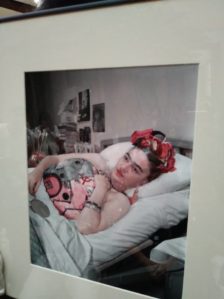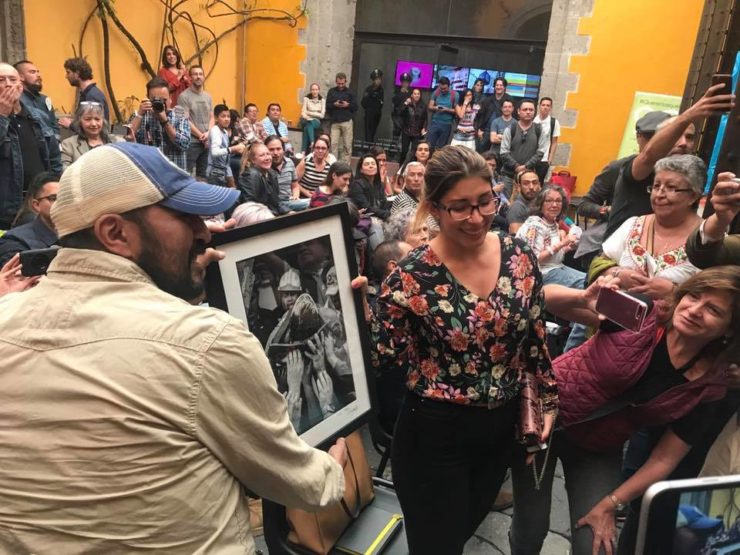Translated from the Spanish by John Gibler. Leer en español.
The collective embrace Photo4Wesley lasted nine hours, four hours longer than planned. The auction was only interrupted because the venue, Centro de la Imagen, had to close. Despite the breathless pace of the auctioneer and the photojournalists who became his helpers, dozens of prints were not shown or sold. No working day could be long enough for all the solidarity of the Mexican and international photographers who donated 280 prints. The donations were for their colleague, Wesley Bocxe from New York, who lost his wife, Elizabeth Esguerra, a photography teacher, and his home, in the September 19 earthquake. Their five-year-old daughter survived.
The auction (FotoXWesley) on Saturday, October 28, in Mexico City, was nine hours of needed community embrace after the earthquake, which the city’s photojournalists offered to those of us who helped out and contributed to this festive mourning celebrating life, this act of love for a colleague in need, this welcome ceremony to recovery.
At the end of the event, we learned that about $24,500 had been raised during the emotional, breathless, fun, moving, and mezcal-fueled afternoon, during which photographic prints that inspired all who looked upon them had been sold. But the success—if that word can be applied to this embrace—can’t be measured in money.
Throughout the day, there were moments registered in the heart, not by cameras, such as when Wesley was connected via live video stream from the hospital so he could watch a bit of the auction. His friends, those who knew him before the quake and those who did not, stood before the camera to applaud and give cheers of encouragement to the man who faced lifting himself up from the rubble of what was his life. That was the only time when the rhythm of the auction paused and the auctioneer was silent.
On the museum’s patio, one of Wesley’s friends excitedly showed to strangers sitting next to him the photo he had taken of Wesley the day before in the hospital, standing with the support of crutches.
The image that would become the prize of the auction was an original 1950s photograph of Frida Kahlo by Juan Guzmán, donated by the Televisa Foundation. In the image, the painter lies in a hospital bed, her brushes behind her. Kahlo is sheathed in the thick body cast that supported her wasted spine, injured in an accident, and which she painted like a canvas. With her hair pulled back in her characteristic buns, and pale as a porcelain doll, she holds a mirror in her hand as her eyes stare into another world.
In an intense bid that provoked screams, the hammer declared the offer of $1,500 was the winner.
Another memorable moment came at the end of the ardent bidding for the image showing the rescue from the rubble of a young man at the hands of numerous volunteers, which became a symbol of the September 19 earthquake. A woman wept with emotion when the hammer named her the winner.
The crowd made way for her to greet the photographer who took the picture—the freelancer Pedro Mera, who had been sitting anonymously among the crowd. The woman hugged him, crying, and whispered something only he could hear. The photographers present captured the moment.
The winner, with her mother, later explained that she works for the city government’s Civil Protections Corps in the Benito Juárez Delegation of Mexico City and that her colleagues participated in the recue portrayed in the photograph. Theirs are surely the raised hands and perhaps some of the faces seen in the picture.
The woman was there when her team rescued the young man, saving his life, and saw the anonymous photographer who captured the moment. She had asked for his contact information, but later could not find the piece of paper where she had written it down. Over the course of the following days, she saw the image published in multiple media outlets—that instant, which both she and the photographer witnessed, when volunteers pulled the young man out of death’s hands. She met Pedro again at the auction and asked him to sign the picture.
Pedro knew of Wesley through the brand of wearable camera and lens cases for photojournalists that Wesley designed and sold. Last year, after working as a photojournalist for 22 years, Pedro decided to retire from journalism and work in commercial photography. The day of the earthquake he felt that particular “itch” of those who have worked in the news media and, by pure instinct, grabbed his camera, walked a few blocks from his house and came upon a collapsed building where some 150 people were working to remove rubble. They had detected two survivors beneath the wreckage.

Pedro stayed put and waited for the rescue. He was surprised to see that everyone there wanted to help the first survivor: Pablo. He looked at the hands stretching out of all those trying to help. He closed his frame to focus in on that detail. He took the picture. The photo, distributed by Getty Images, was published by international media. Pedro continued documenting the damage wreaked by the quake.
Four days later, on September 22, Pedro went through his archive and converted the photograph from its original horizontal frame to a vertical one, by cutting from both sides of the central image. He then converted it to black and white and posted it to his Instagram page. That Sunday he discovered that the image had gone viral, with thousands of people sharing it.
“That Sunday I realized that people were adopting the image as a representation of all that was positive in what had come about after the quake,” Pedro told me.
After the September 19, 1985 earthquake in Mexico City, it was Wesley Bocxe who memorialized the rescue efforts. At that time, Wesley worked for Reuters and his photographs were seen around the world.
Thirty-two years later, last September 19, Wesley was with his wife Elizabeth in their apartment on the seventh floor of the building on the corner of Amsterdam and Laredo in the Condesa neighborhood. Their daughter was at school. When Wesley and Elizabeth felt the quake, they ran up towards the roof, taking the spiral staircase. The building threw Wesley. He survived the fall and was rescued alive. Elizabeth died in the building’s collapse.
Wesley’s photojournalist friends who were out in the streets covering the earthquake, upon hearing of his building’s collapse, passed by the mountain of wreckage again and again during their coverage. They knew the building well. They had often gone there to purchase vests and lens cases from Wesley’s Newswear gear brand.
A number of colleagues took turns waiting at the site for Wesley and Elizabeth to be rescued. They watched, powerlessly, how the photographic archive of all the wars Wesley had covered lay scattered amongst the stones and debris. They also documented how the hip pouches Wesley had specifically designed for the tribe of photojournalists so they could have their hands free to work their cameras were being used by rescuers to carry their tools and cell phones.
When the photographers learned that Wesley had been hospitalized but that Elizabeth had not been found, they kept up their vigil. Several asked about her when they went to take photos at various hospitals and morgues. And then they found her. They asked that the news of her death not be made public—it was a secret amongst the journalists for several days—so that Wesley would not suffer an emotional collapse while in intensive care.
A few days later the idea of Photos4Wesley (FotoXWesley) began to circulate. Some 250 photographers from Mexico as well as some from Perú, Chile, the United States and Argentina donated framed prints. This was the third such photo auction organized in solidarity with journalists. The first was Photos4Goyo (FotoXGoyo) in 2014, organized to raise funds for the widow and orphans of Gregorio Jiménez, murdered in Veracruz during the wave of murders of journalists in that state. The second auction, in 2015, was Photos4Rubén (FotoxRubén), in solidarity with Rubén Espinosa, who sought refuge in Mexico City, fleeing from what he thought was an execution order against him for his work in Veracruz. Rubén Espinosa was murdered in Mexico City on July 31, 2015.
Just as in the photograph by Pedro Mera, the community of photojournalists extended their arms to rescue a colleague, to embrace the family of a murdered colleague, to pay for the funeral of another murdered colleague. Showing solidarity and giving others the opportunity to show their solidarity.



